In the Age of Digital, every business is a software business.
Agility isn’t an option, or a thing just for technical teams, it is a business imperative.
—Dean Leffingwell, Creator of SAFe
SAFe 5 for Lean Enterprises
SAFe for Lean Enterprises is the world’s leading framework for business agility. SAFe integrates the power of Lean, Agile, and DevOps into a comprehensive operating system that helps enterprises thrive in the digital age by delivering innovative products and services faster, more predictably, and with higher quality.Configurable and scalable, SAFe allows each organization to adapt the framework to its own business needs. With four out-of-the-box configurations, SAFe supports the full spectrum of solutions, from those requiring a small number of teams to those complex systems that require hundreds—and even thousands—of people to build and deliver.
Business Benefits of SAFe
Surviving in the age of digital is not guaranteed. Business agility isn’t an option; it’s imperative. Even businesses that don’t consider themselves Information Technology (IT) or software companies—professional services, financial services, manufacturers, healthcare institutions, defense contractors, government agencies, and more—are now all highly dependent on their ability to rapidly produce new, high-quality, innovative, digitally-enabled products and services.
The mission of Scaled Agile, Inc. (SAI), the provider of SAFe, is to help enterprises grow their business through the Framework’s knowledge base. SAI also offers certification, training, courseware, community resources, and a global network of more than 400 service, tooling, and Global service partners.
Improves Business Outcomes
Created from over a decade of field experience, SAFe draws from four primary bodies of knowledge: Agile development, systems thinking, Lean product development, and DevOps. It helps enterprises answer the following types of questions:
- How do we align technology development to strategic business goals?
- How do we deliver new value on a predictable schedule so the business can plan?
- How do we improve the quality of our solutions and delight our customers?
- How do we scale Agile practices from teams to ARTs and across value streams and the enterprise to deliver better results?
- How do we organize people around value so that our programs deliver effectively and avoid the delays inherent in a traditional, functional structure?
- How do we create an environment that fosters collaboration, innovation, and relentless improvement for our people?
- How can we change our culture so that it is safe to fail? How do we encourage people to take risks, think creatively, and embrace continuous learning? How can we help our teams improve without getting in the way?
By adopting SAFe—and applying its well-described set of values, principles, and practices—the enterprise can address these questions and realize more significant business and individual benefits.
SAFe 5 enables business agility and improving business outcomes for organizations of all sizes across the world. SAFe has produced dramatic improvements in time to market, employee engagement, higher quality, higher customer satisfaction, and overall improved economic outcomes. It also helps create cultures that are more productive, rewarding, and fun.
Figure 1 highlights these benefits as derived directly from Case Studies written by SAFe customers.
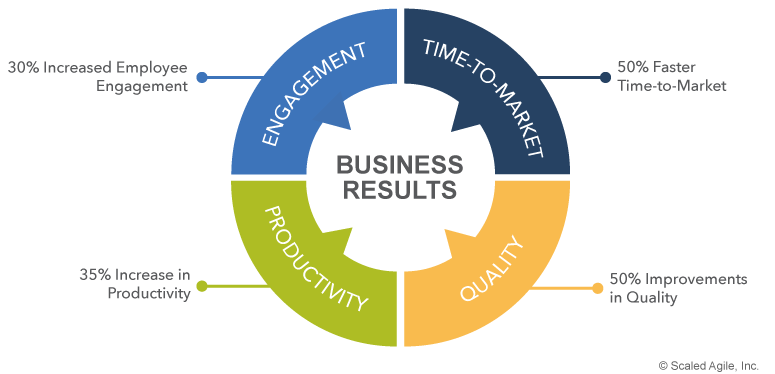
“We had multiple waterfall efforts, third-party integration, and a hard, regulatory mandate that made coordination and execution exceptionally difficult. SAFe provided the agility, visibility, and transparency needed to ensure we could integrate with the numerous other efforts, get predictable in our delivery, and ensure timelines are met.”
— David McMunn, the Director of Fannie Mae’s Agile Center of Excellence (COE)
SAFe Evolves Continuously
A hallmark of SAFe is that it stays current with new and evolving business and technology trends. Our incremental delivery model enables enterprises to adapt more quickly and stay ahead of the competition by leveraging the latest knowledge in SAFe. For example, COVID-19 forced many organizations to change how Agile teams and ARTs collaborate. In response, the guidance for PI Planning, Organizational Agility, and Agile Teams were quickly updated.
Most updates to SAFe simply require changes to various articles and new advanced topics. Sometimes, however, updates to the Big Picture (BP) are needed for emphasis and to provide ready access to the latest content. Minor releases of the BP occur under a ‘dot release” like the current BP version 5.1. Such minor releases are truly incremental and do not require upgrades to training and certification.
Over time, the incremental advances and significant new knowledge drive the release of a new version, as was the case with SAFe 5—which extended SAFe into true business agility. In these cases, SAFe practitioners and SPCs must keep pace with upgraded knowledge, training, and certification.
To help our community keep current with the latest guidance, we’ve introduced a new feature that provides a log of meaningful incremental changes on the home page under the heading, ‘What’s New in SAFe.’ When you click on a change item, it will open a blog post to inform our readers of the ‘why’ and ‘what’ for the changes.
Introduction to SAFe 5.1 Big Picture
The SAFe Framework website features an interactive ‘Big Picture’ graphic. It provides a visual model of the Framework and is the primary user interface to the knowledgebase. Each icon of the image is clickable and offers access to extensive SAFe guidance. The configurations support a full range of development and business environments and the foundational principles, values, mindset, roles, artifacts, and implementation elements that make up the SAFe framework.
The main components of the SAFe framework are described in the following sections.
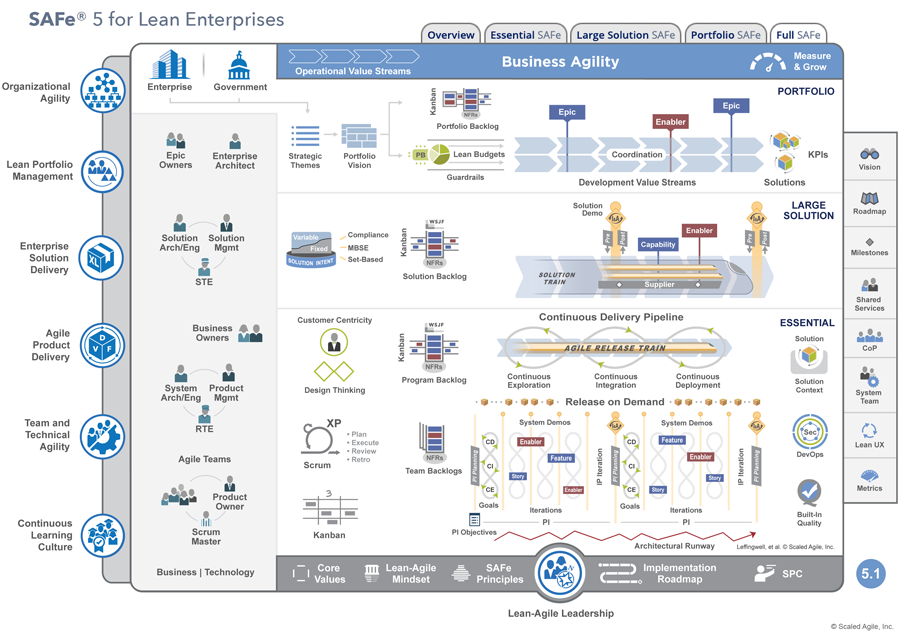
Overview
SAFe 5 includes an overview tab shown in Figure 3. This graphic provides a simplified view of SAFe’s Seven Core Competencies of the Lean Enterprise and their twenty-one dimensions that enable business agility. The focal point for all the competencies is the customer. Lean-Agile Leadership is the foundation. Measure and Grow at the top right is a reminder of periodic assessments needed to track the organization’s progress towards the principles and practices that enable business agility. This overview is a useful tool for providing an initial orientation to SAFe, introducing the business agility assessment, and framing executive briefings.
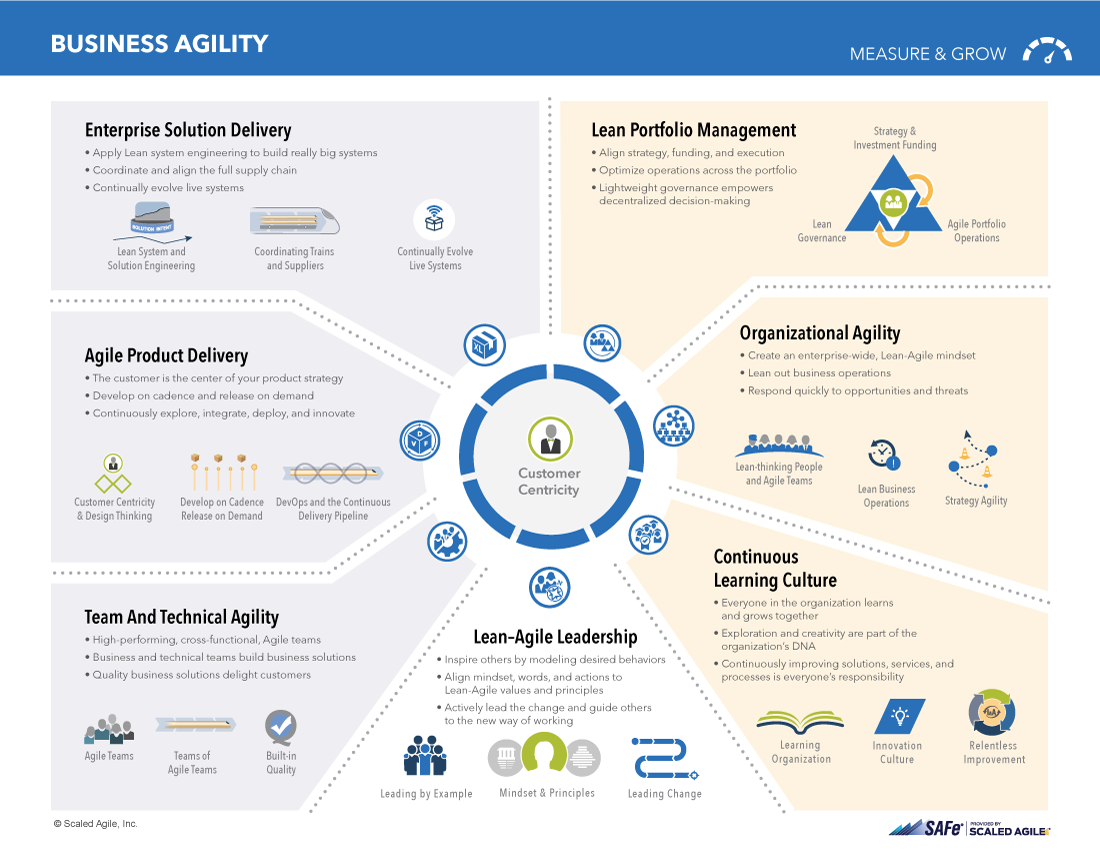
Seven Core Competencies of the Lean Enterprise
SAFe 5 is built around the Seven Core Competencies of the Lean Enterprise. These competencies include major re-writes to the original five competencies introduced in SAFe 4.6, along with two entirely new competencies (Organizational Agility and Continuous Learning Culture). The competencies are the primary lens for understanding and implementing SAFe, as illustrated in the Overview tab on the Big Picture.
Each of the following competencies offers the knowledge, skills, and behaviors, enabling enterprises to achieve business agility:
Team and Technical Agility
It all starts with Agile development, the cornerstone of Business Agility. The Team and Technical Agility competency describe the critical skills and Lean-Agile principles and practices that high-performing Agile teams and Teams of Agile teams use to create high-quality solutions for their customers. It consists of three dimensions, as illustrated in Figure 4:
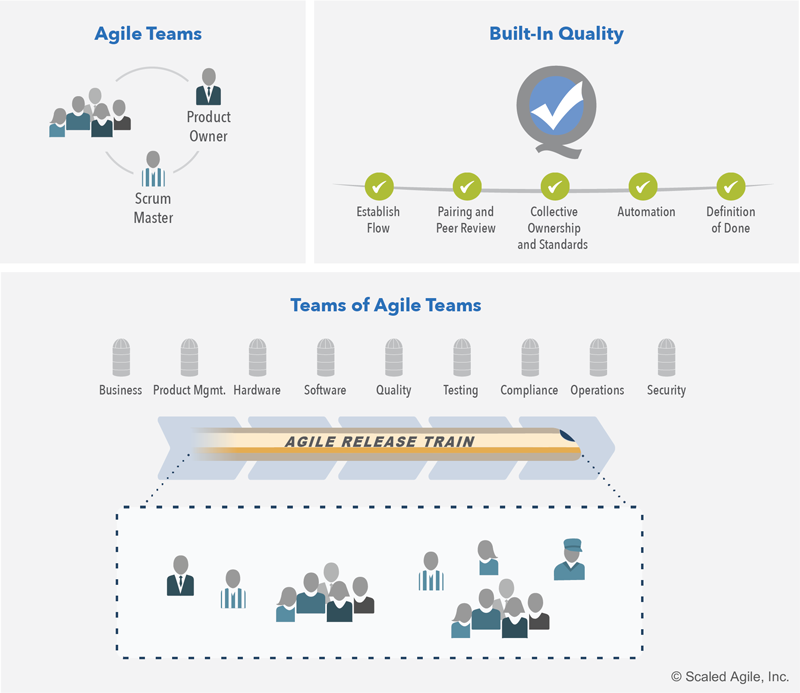
- Agile Teams – High-performing, cross-functional teams anchor the competency by applying effective Agile principles and practices.
- Team of Agile Teams – Agile teams operate within the context of a SAFe Agile Release Train (ART), a long-lived, team of Agile teams that provides a shared vision and direction and is ultimately responsible for delivering solution outcomes.
- Built-in Quality – All Agile teams apply defined Agile practices to create high-quality, well-designed solutions that support current and future business needs.
Agile Product Delivery
Business Agility demands that enterprises rapidly increase their ability to deliver innovative products and services. To be sure, the enterprise is creating the right solutions for the right customers at the right time; they must balance their execution focus with a customer focus. These capabilities are mutually supportive and create opportunities for sustained market and service leadership. Agile Product Delivery is a customer-centric approach to defining, building, and releasing a continuous flow of valuable products and services to customers and users.
There are three dimensions to Agile Product Delivery, as illustrated in Figure 5.
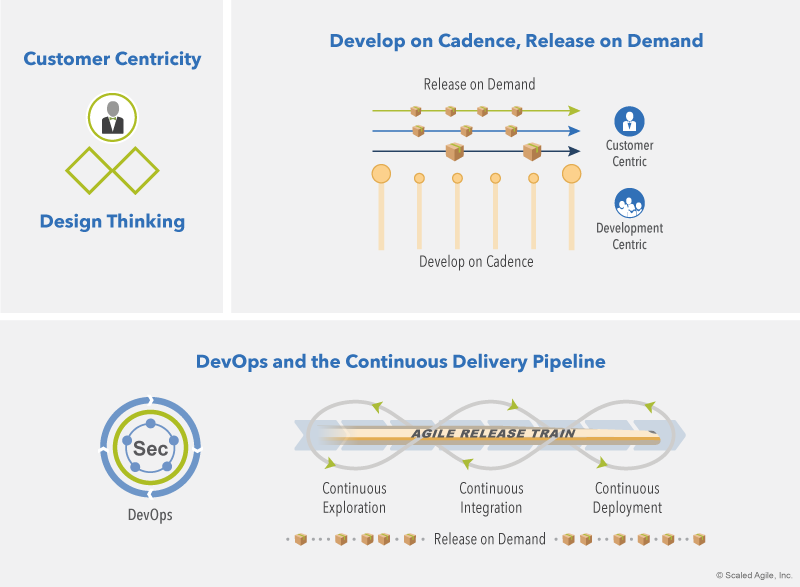
Customer Centricity and Design Thinking – Customer centricity puts the customer at the center of every decision and uses design thinking to ensure the solution is desirable, feasible, viable, and sustainable.
Develop on Cadence; Release on Demand – Developing on cadence helps manage the variability inherent in product development. Decoupling the release of value from that cadence ensures customers can get what they need when they need it.
DevOps and the Continuous Delivery Pipeline – DevOps and the Continuous Delivery Pipeline creates the foundation that enables enterprises to release value, in whole or in part, at any time it’s needed.
Enterprise Solution Delivery
Building and evolving large, enterprise solutions is a monumental effort. Many such systems require hundreds or thousands of engineers. They demand sophisticated, rigorous practices for engineering, operations, and support. Moreover, over the decades that these systems are operational, their purpose and mission evolve. That calls for new capabilities, technology upgrades, security patches, and other enhancements. As true ‘living systems,’ the activities above are never really ‘done.’ Instead, they are released earlier and further developed over time.
The Enterprise Solution Delivery competency describes how to apply Lean-Agile principles and practices to the specification, development, deployment, operation, and evolution of the world’s largest and most sophisticated software applications, networks, and cyber-physical systems. It consists of three dimensions. (Figure 6).
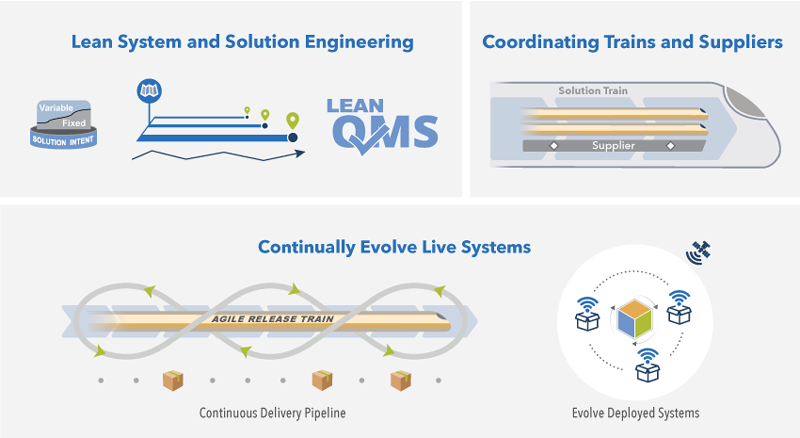
Lean System and Solution Engineering applies Lean-Agile practices to align and coordinate all the activities necessary to specify, architect, design, implement, test, deploy, evolve, and ultimately decommission these systems.
Coordinating Trains and Suppliers coordinates and aligns the extended set of value streams to a shared business and technology mission. It uses the coordinated Vision, Backlogs, and Roadmaps with common Program Increments (PI) and synchronization points.
Continually Evolve Live Systems ensures both the development pipeline and the large systems themselves support continuous delivery of value, both during and after, release into the field.
Lean Portfolio Management
The three competencies above provide the technical practices needed to build and deploy meaningful business solutions. But none of them directly address the more significant issue of why those solutions are required, how they are funded and governed, and what other solutions are necessary to deliver complete enterprise value. For that, we need to address portfolio concerns. However, traditional approaches to portfolio management were not designed for the impact of digital disruption. These factors put pressure on enterprises to work under a higher degree of uncertainty, and yet deliver innovative solutions much faster. Portfolio Management approaches must be modernized to support the new Lean-Agile way of working. The Lean Portfolio Management competency aligns strategy and execution by applying Lean and systems thinking. As Figure 7 illustrates, it accomplishes this through three collaborations for strategy and investment funding, Agile portfolio operations, and Lean governance.
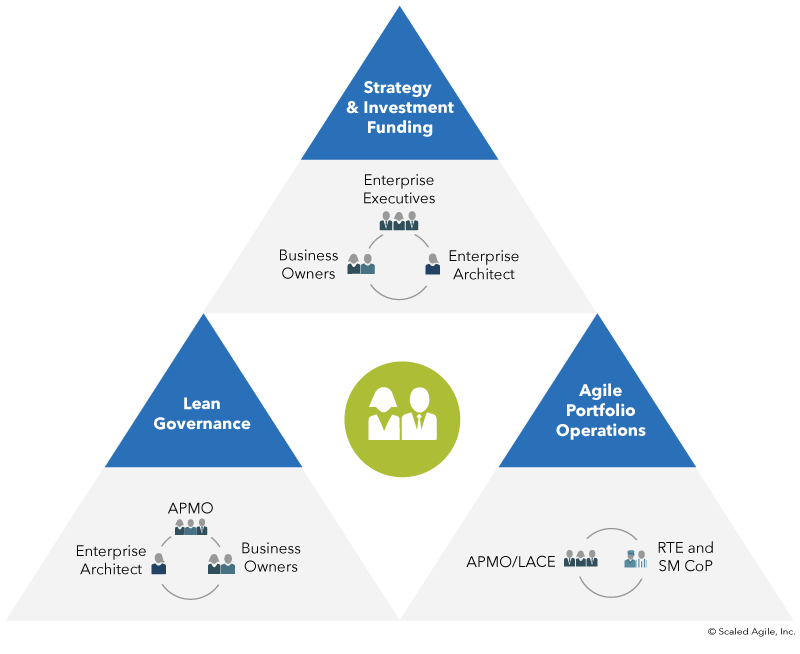
Strategy and Investment Funding ensures that the entire portfolio is aligned and funded to create and maintain the solutions needed to meet business targets. It requires the cooperation of Business Owners, portfolio stakeholders, technologists, and Enterprise Architects.
Agile Portfolio Operations coordinates and supports decentralized program execution, enabling operational excellence. It requires the cooperation of the Agile Program Management Office/Lean-Agile Center of Excellence (APMO/LACE) and Communities of Practice (CoPs) for Release Train Engineers (RTEs) and Scrum Masters.
Lean Governance manages spending, audit and compliance, forecasting expenses, and measurement. It requires the engagement of the Agile PMO/LACE, Business Owners, and Enterprise Architects.
Organizational Agility
Even with the competencies above, the enterprises must be able to change quickly to respond to the challenges and opportunities that today’s rapidly evolving markets present. This requires more flexibility and adaptability than the hierarchical operating system is likely to be able to muster. Again, we turn to the second operating system for help. SAFe helps businesses address these challenges with Organizational Agility, which is expressed in three dimensions (Figure 8):
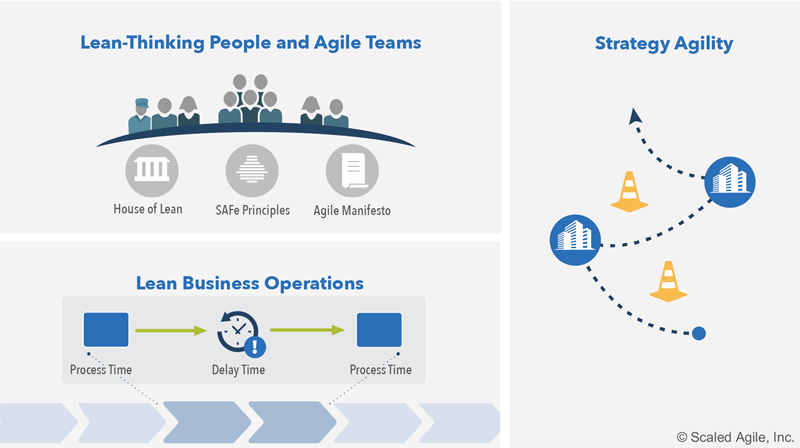
Lean-Thinking People and Agile Teams – This state occurs when everyone involved in solution delivery is trained in Lean and Agile methods and embraces and embodies the values, principles, and practices.
Lean Business Operations – Teams apply Lean principles to understand, map, and continuously improve the business processes that support the business’s products and services.
Strategy Agility – This state occurs when the enterprise shows the ability and adaptability needed to sense the market and quickly change strategy when necessary continuously.
Continuous Learning Culture
And even with mastery of the above, there can be no final state. Startup companies will continue to challenge the status quo. Juggernaut companies like Amazon and Google are entering entirely new markets such as banking and healthcare. Expectations from new generations of workers, customers, and society as a whole challenges companies to think and act beyond balance sheets and quarterly earnings reports.
To address the demand for continuous learning, growth of its people, and improvement in processes, the Continuous Learning Culture competency describes a set of values and practices that encourage individuals—and the enterprise as a whole—to continually increase knowledge, competence, performance, and innovation. It is expressed in three dimensions, as shown in Figure 9.
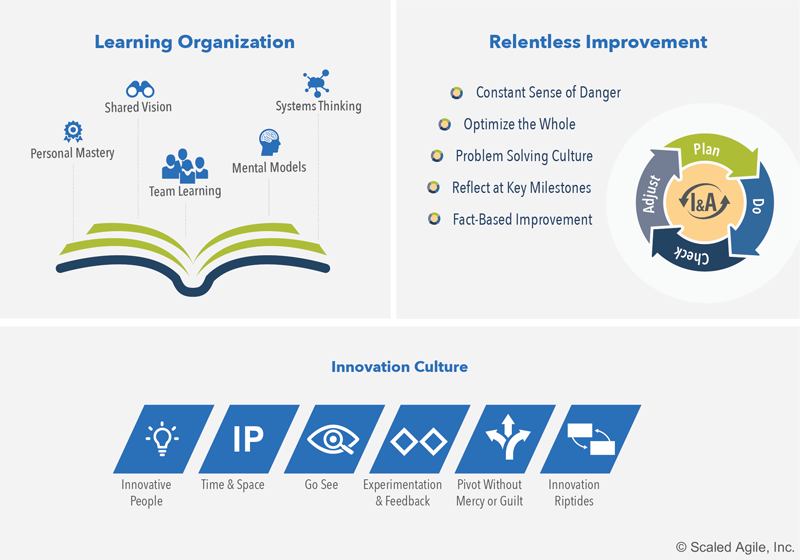
The three dimensions are:
Learning Organization – Employees at every level are learning and growing so that the organization can transform and adapt to an ever-changing world.
Innovation Culture – Employees are encouraged and empowered to explore and implement creative ideas that enable future value delivery.
Relentless Improvement – Every part of the enterprise focuses on continuously improving its solutions, products, and processes.
Lean-Agile Leadership
Finally, we recognize that an organization’s managers, executives, and other leaders provide the foundation ultimately responsible for the adoption and success of Lean-Agile development and mastery of the competencies that lead to Business Agility. Only they have the authority to change and continuously improve the systems that govern how work is performed. Only they can create an environment that encourages high-performing Agile teams to flourish and produce value. Leaders, therefore, must internalize and model leaner ways of thinking and operating so that team members will learn from their example, coaching, and encouragement.
By helping leaders develop along three dimensions, as illustrated in Figure 10, organizations can establish the core competency of Lean-Agile Leadership.
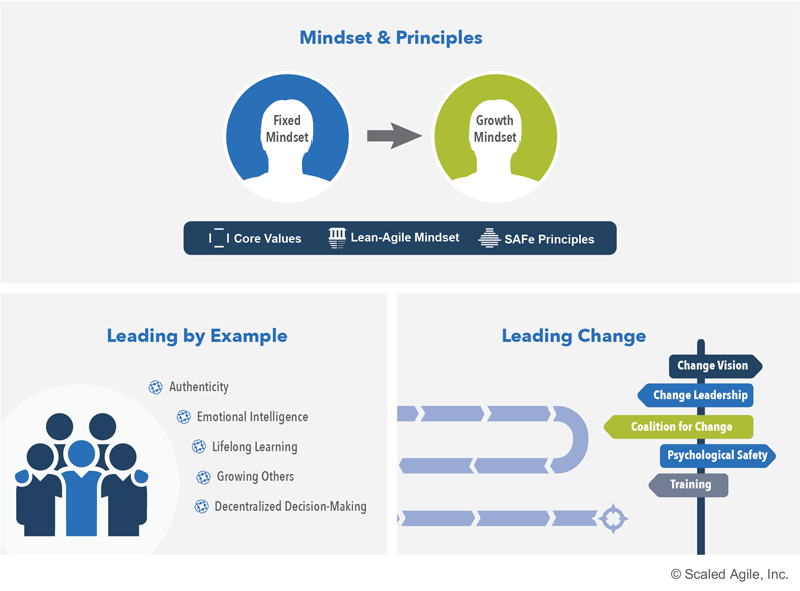
Leading by Example – Leaders gain earned authority by modeling the desired behaviors for others to follow, inspiring them to incorporate the leader’s example into their development journey.
Mindset and Principles – By embedding the Lean-Agile way of working in their beliefs, decisions, responses, and actions, leaders model the expected norm throughout the organization.
Leading Change – Leaders lead (rather than support) the transformation by creating the environment, preparing the people, and providing the necessary resources to realize the desired outcomes.
SAFe for Government
SAFe 5 continues to expand guidance for Lean-Agile adoption in Government. Based on the foundation and principles of SAFe, the guidance emphasizes:
- Building on a solid foundation of Lean-Agile values, principles, and practice
- Creating high performing teams of government teams and contractor personnel
- Aligning technology investments with agency strategy
- Transitioning from projects to a Lean flow of epics
- Adopting Lean budgeting aligned to value streams
- Applying Lean estimating and forecasting on cadence
- Modifying acquisition practices to enable Lean-Agile development and operations
- Building in quality and compliance
- Adapting governance practices to support agility and Lean flow of value
The government article is a unique element within the Framework. It’s a portal to a series of articles on SAFe adoption in the public sector, providing links to Agile government resources, videos, and events. Many of them are hard to find, and some are available only through our government portal. Our portal is a small way SAI gives back to the thousands of dedicated civil servants and their industry partners working tirelessly to bring agility to government.
SAFe Configurations
SAFe supports the full range of development environments with four out-of-the-box configurations. The configurations can be accessed using the tabs shown in Figure 1. Each is described in the following sections.
Essential SAFe
The Essential SAFe configuration is the basic building block for all SAFe configurations and is the simplest starting point for implementation. This competency builds on the principles and practices found in the Lean-Agile Leadership, Team and Technical Agility, and the Agile Product Delivery competencies.
SAFe is anchored by an organizational structure called the Agile Release Train (ART), where Agile teams and key stakeholders are dedicated to a meaningful, ongoing solution mission.
Essential SAFe includes both the Agile team and ART constructs, as shown in Figure 11.
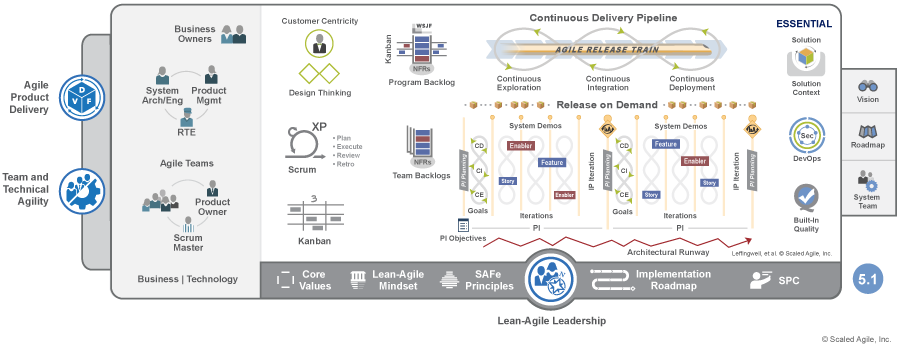
Large Solution SAFe
Such solution development is typical for aerospace and defense, automotive, and government industries, where the large solution—not portfolio governance—is the primary concern.
The Solution Train organizational construct helps enterprises with the biggest challenges—building large-scale, multidisciplinary software, hardware, cyber-physical, and complex IT systems. Developing these solutions requires additional roles, artifacts, events, and coordination, as Figure 12 illustrates.
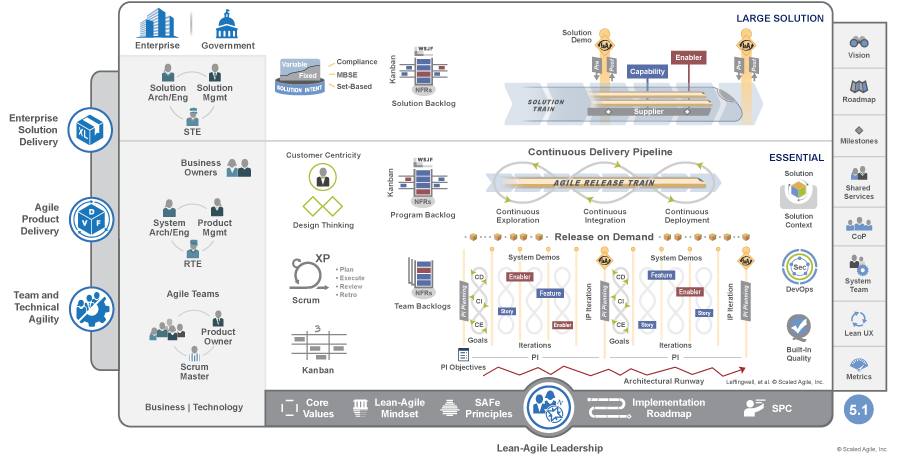
Portfolio SAFe
The Portfolio SAFe configuration is the minimum set of competencies and practices that can fully enable business agility, as indicated by the blue ‘Business Agility’ bar at the top. This bar also includes a link to Measure & Grow for guidance on conducting SAFe business agility assessments. Portfolio SAFe provides two additional competencies, Organizational Agility and Lean Portfolio Management, beyond the three core competencies of Essential SAFe. Lean Portfolio Management aligns portfolio execution to enterprise strategy and organizes development around the flow of value through one or more value streams. Organization Agility extends Lean thinking and practice throughout the enterprise and enables strategy agility. Continuous Learning Culture describes how everyone in the organization learns together, relentlessly improves, and builds innovation into the culture. In addition to the competencies, Portfolio SAFe provides principles and practices for portfolio strategy and investment funding, Agile portfolio operations, and Lean governance.
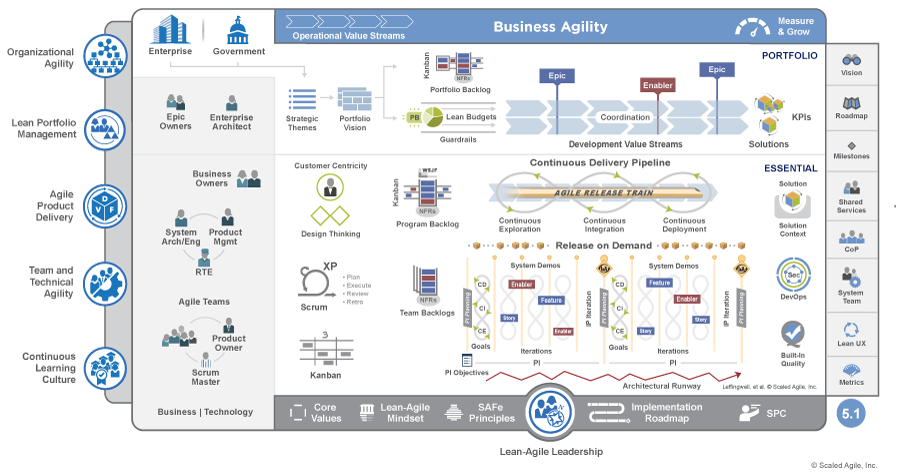
Full SAFe
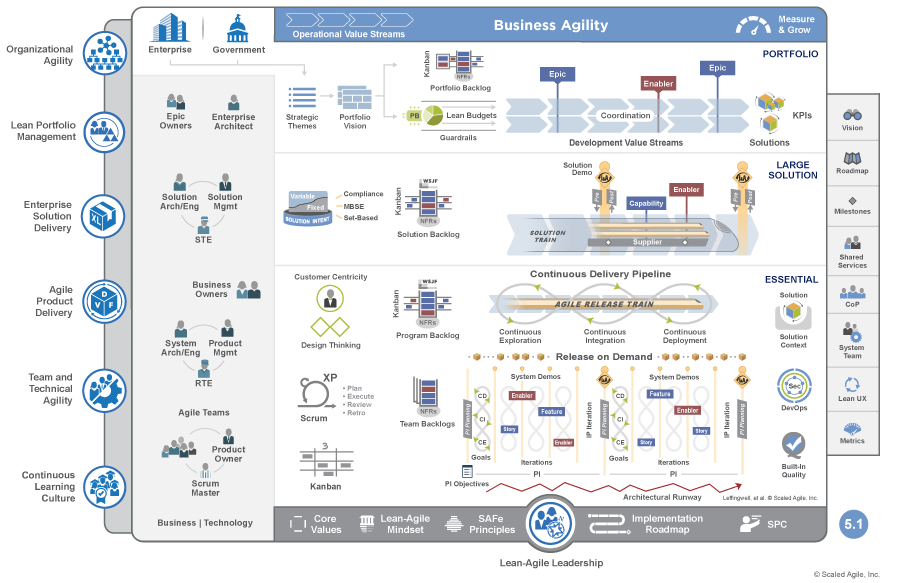
Spanning Palette
The Spanning Palette contains various roles and artifacts that may apply to a specific team, program, large solution, or portfolio context.
An essential element of SAFe’s flexibility and adaptability, the spanning palette contains additional guidance elements that can be used in specific contexts. Figure 15 illustrates two versions of the spanning palette. The leftmost figure is used by the Essential SAFe configuration, while the rightmost one serves all other configurations. However, since SAFe is a framework, enterprises can apply any item from the larger spanning palette to Essential SAFe.
Below is a brief description of each spanning palette element:
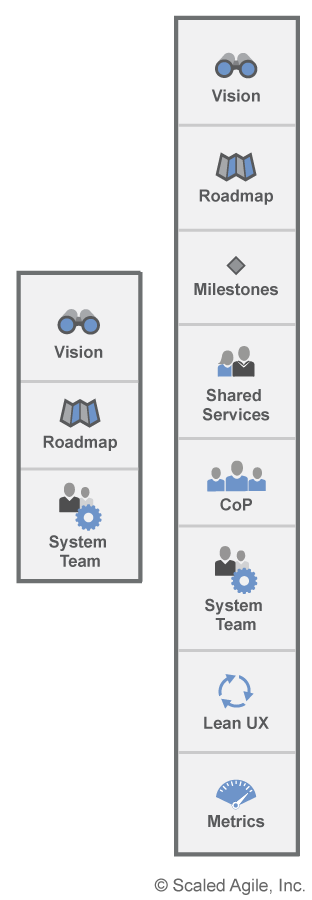
- Vision – The vision describes a future view of the solution to be developed, reflecting customer and stakeholder needs and the Features and Capabilities proposed to address those needs.
- Roadmap – The roadmap communicates planned ART and value stream deliverables and milestones over a timeline.
- Milestones – Milestones are used to define important events on a roadmap. SAFe describes fixed-date, Program Increment (PI), and learning milestones.
- Shared Services – Represents the specialty roles necessary for an ART or Solution Train’s success but cannot be dedicated full time to any specific train.
- Community of Practice (CoP) – A community of practice is an informal group of team members and other experts, acting within the context of a program or enterprise, that has a mission of sharing practical knowledge in one or more relevant domains.
- System Team – The system team is a special Agile team that provides assistance in building and using the continuous delivery pipeline, and where necessary, validating full end-to-end system performance.
- Lean User Experience (UX) – Lean UX brings Lean principles to user experience design. It uses an iterative, hypothesis-driven approach to product development through constant measurement and learning loops (build-measure-learn).
- Metrics –SAFe’s three measurement domains, Outcomes, Flow, and Competency, provide a comprehensive, yet simple, model for measuring progress toward business agility.
Foundation
The Foundation contains the supporting principles, values, mindset, implementation guidance, and leadership roles needed to deliver value successfully at scale.

- Figure 16. SAFe Foundation
Each foundation element illustrated in Figure 16 is briefly described next.
- Lean-Agile Leaders – Management has the ultimate responsibility for business outcomes. Leaders are trained in SAFe and become trainers of these leaner and more agile ways of thinking and working. To this end, SAFe describes a new leadership style exhibited by the enterprise’s new ‘Lean-thinking manager-teachers’.
- Core Values – Four core values of Alignment, Built-In Quality, Transparency, and Program Execution define the belief and value system for SAFe.
- Lean-Agile Mindset – The Lean-Agile Mindset is the combination of beliefs, assumptions, attitudes, and actions of SAFe leaders and practitioners who embrace the concepts of the Agile Manifesto and Lean thinking. It’s the personal, intellectual, and leadership foundation for adopting and applying SAFe principles and practices.
- SAFe Principles – SAFe practices are grounded in ten principles that synthesize Agile methods, Lean product development, DevOps, and systems thinking, coupled with decades of practical field experience.
- Implementation Roadmap – Implementing the changes necessary to become a Lean-Agile technology enterprise is a substantial change for most companies. SAFe provides an implementation roadmap to help guide organizations on this journey.
- SPCs – SAFe Program Consultant (SPCs) are change agents who combine their technical knowledge of SAFe with an intrinsic motivation to improve their company’s software and systems development processes.
Learn More
[1] Knaster, Richard, and Dean Leffingwell. SAFe 5.0 Distilled: Achieving Business Agility with the Scaled Agile Framework. Addison-Wesley, 2020.
Last update: 22 July 2021





